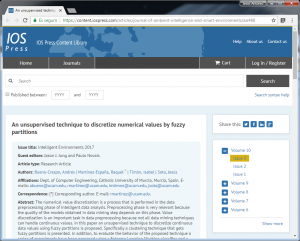Presentación de Muret
El pasado día 21 de febrero presentamos Muret en Santomera. Os dejo el reportaje que hicieron en 7 Televisión Región de Murcia.
Novela histórica Muret

Ya está a la venta mi novela MURET.
En ella relato la historia de Adán de Alascún, un joven aragonés cuya vida da un vuelco la noche que se celebra la victoria en la batalla de las Navas de Tolosa. Resignado por el peso de la culpa, descubre que su pasado ha sido un engaño. Un engaño que comenzó unos años atrás, cuando iba a casarse con su amada. Pronto un oscuro secreto se cobijará en su interior, que lo conducirá hacia el único propósito que lo mantiene vivo: la venganza.
La novela nos relata una historia de amor, traición y poder en el devenir del reino de Aragón. A través de sus páginas cabalgaremos parejos a la historia de Aragón en Occitania. Estaremos presentes en momentos decisivos que explican la cruzada cátara; la situación feudal de Occitania en el siglo XIII; la injerencia de los reinos colindantes por el dominio de una tierra rica y la influencia de la Corona de Aragón.
De la mano del joven Alascún viviremos el amor, el odio y la sinrazón que llevaba a los caballeros medievales a morir en las batallas. Adán nos guiará por un entramado de caminos de orgullo, ambición y felonía que confluirá en la villa de Muret. El castillo de Muret será testigo mudo de reyes vasallos, condes más poderosos que sus señores y cruzados que solo se arrodillan ante la cruz. Unas murallas frente a las que todos empeñarán sus destinos a un Juicio de Dios.
Developing an intelligent system for the prediction of soil properties with a portable mid-infrared instrument
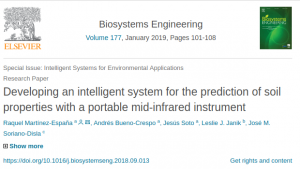 Ya está disponible nuestro nueva publicación.
Ya está disponible nuestro nueva publicación.
Developing an intelligent system for the prediction of soil properties with a portable mid-infrared instrument.
Highlights
- •Different machine learning techniques have been tested to predict soil properties.
- •The predicted soil properties are TC, TN, CEC, clay, silt and Na+.
- •The best predictive machine learning technique has been the Gaussian Process.
- •The Gaussian process is better compared to the traditional PLSR technique.
- •The Gaussian Process is the candidate for the development of intelligent system.
Air-Pollution Prediction in Smart Cities through Machine Learning Methods
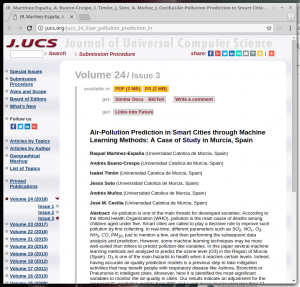
Estamos de suerte, al final nos han aceptado el artículo que llevamos meses en revisión.
Air-Pollution Prediction in Smart Cities through Machine Learning Methods: A Case of Study in Murcia, Spain
Abstract:Air-pollution is one of the main threats for developed societies. According to the World Health Organization (WHO), pollution is the main cause of deaths among children aged under five. Smart cities are called to play a decisive role to improve such pollution by first collecting, in real-time, different parameters such as SO2, NOx, O3, NH3, CO, PM10, just to mention a few, and then performing the subsequent data analysis and prediction. However, some machine learning techniques may be more well-suited than others to predict pollution-like variables. In this paper several machine learning methods are analyzed to predict the ozone level (O3) in the Region of Murcia (Spain). O3 is one of the main hazards to health when it reaches certain levels. Indeed, having accurate air-quality prediction models is a previous step to take mitigation activities that may benefit people with respiratory disease like Asthma, Bronchitis or Pneumonia in intelligent cities. Moreover, here it is identified the most-significant variables to monitor the air-quality in cities. Our results indicate an adjustment for the proposed O3 prediction models from 90% and a root mean square error less than 11 μ/m3 for the cities of the Region of Murcia involved in the study.
An unsupervised technique to discretize numerical values by fuzzy partitions
Una nueva publicación con técnicas aplicadas al análisis de datos.
An unsupervised technique to discretize numerical values by fuzzy partitions.
Abstract:
The numerical value discretization is a process that is performed in the data preprocessing phase of intelligent data analysis. Preprocessing phase is very relevant because the quality of the models obtained in data mining step depends on this phase. Value discretization is an important task in data preprocessing because not all data mining techniques can handle continuous values. In this paper an unsupervised technique to discretize continuous data values using fuzzy partitions is proposed. Specifically a clustering technique that gets fuzzy partitions is presented. In addition, to evaluate the behavior of the proposed technique a series of experiments have been proposed using a Extreme Learning Machine classifier and a committee of Extreme Learning Machine. Beside comparing with the K-means discretization technique. These experiments have been validated statistically obtaining the best results the approach proposed.
High-Throughput Infrastructure for Advanced ITS Services
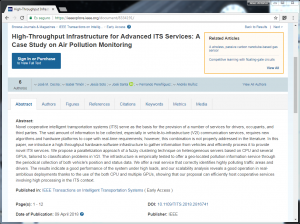 Hoy nos han comunicado la publicación de un nuevo artículo, con el que llevábamos trabajando desde el año pasado.
Hoy nos han comunicado la publicación de un nuevo artículo, con el que llevábamos trabajando desde el año pasado.
High-Throughput Infrastructure for Advanced ITS Services: A Case Study on Air Pollution Monitoring.
Abstract:
Novel cooperative intelligent transportation systems (ITS) serve as the basis for the provision of a number of services for drivers, occupants, and third parties. The vast amount of information to be collected, especially in vehicle-to-infrastructure (V2I) communication services, requires new algorithms and hardware platforms to cope with real-time requirements; however, this combination is not properly addressed in the literature. In this paper, we introduce a high-throughput hardware-software infrastructure to gather information from vehicles and efficiently process it to provide novel ITS services. We propose a parallelization approach of a fuzzy clustering technique on heterogeneous servers based on CPU and several GPUs, tailored to classification problems in V2I. The infrastructure is empirically tested to offer a geo-located pollution information service through the periodical collection of both vehicle’s position and status data. We offer a real service that correctly identifies highly polluting traffic areas and drivers. The results indicate a good performance of the system under high loads, and our scalability analysis reveals a good operation in real-ambitious deployments thanks to the use of the both CPU and multiple GPUs, showing that our proposal can efficiently host cooperative services involving high processing in the ITS context.
A novel fuzzy clustering approach to regionalise watersheds
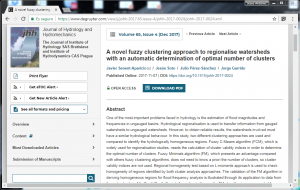 Otra artículo que nos publican: A novel fuzzy clustering approach to regionalise watersheds with an automatic determination of optimal number of clusters. Una nueva aplicación de los algoritmos de clasificación difusa.
Otra artículo que nos publican: A novel fuzzy clustering approach to regionalise watersheds with an automatic determination of optimal number of clusters. Una nueva aplicación de los algoritmos de clasificación difusa.
Abstract
One of the most important problems faced in hydrology is the estimation of flood magnitudes and frequencies in ungauged basins. Hydrological regionalisation is used to transfer information from gauged watersheds to ungauged watersheds. However, to obtain reliable results, the watersheds involved must have a similar hydrological behaviour. In this study, two different clustering approaches are used and compared to identify the hydrologically homogeneous regions. Fuzzy C-Means algorithm (FCM), which is widely used for regionalisation studies, needs the calculation of cluster validity indices in order to determine the optimal number of clusters. Fuzzy Minimals algorithm (FM), which presents an advantage compared with others fuzzy clustering algorithms, does not need to know a priori the number of clusters, so cluster validity indices are not used. Regional homogeneity test based on L-moments approach is used to check homogeneity of regions identified by both cluster analysis approaches. The validation of the FM algorithm in deriving homogeneous regions for flood frequency analysis is illustrated through its application to data from the watersheds in Alto Genil (South Spain). According to the results, FM algorithm is recommended for identifying the hydrologically homogeneous regions for regional frequency analysis.

